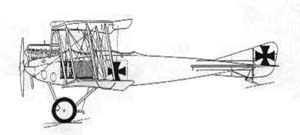Luedemann Resin 1/72 DFW B.I |  | The plane. Popular on the WWI Western Front under the nickname 'Banana-plane' (look at the shape of the wings!), the DFW B.I was one of the early-war German unarmed two-seaters, widely used for the reconnaissance and army-cooperation. Produced by the Deutsche Flugzeugwerke in Leipzig, it was also sold to the Austro-Hungarian aviation, where gained some popularity, as in the famous Komarow battle, in the end of the August 1914, two future Austro-Hungarian fighter aces, Rudolf Holeka and Heinrich Kostrba flying the DFW B.I brought back decisive information, which helped the army to brilliantly defeat the Russians. Kostrba and Holeka were awarded for that action with the one of the highest Austrian decorations, Militaerverdienstkreuz third class. The Kit Typically for the Luedemann Resins, this kit is packed with the plastic bag, there are no decals and only the very basic instruction sheet is provided. But the rest is veeeeery good. Kit parts are very well moulded in ivory-coloured resin. Kit external surfaces are probably some of the best ones available in resin kits: wings are very thin, with delicate ribs and sharp edges, and the fuselage side details are stunning - look at the provided close-up photo! Louvres, fabric lacing, inspection panels - all this is present, and very good looking. Some few small air-bubbles are present, but nothing which can't be easily fixed with a drop of putty. Smaller details are less ideal: very highly and beautifully detailed, but some of them contain moulding faults, proving that it is sometimes easier to make new parts from scratch, than to repair the kit parts. This applies mostly to the wing struts. Cabane struts are the best I've ever seen, and are even wrapped with the depiction of some very thin cables or lines (fuel lines?). Another problem is that some interior details are somewhat 'generic', and should be a bit corrected and rearranged to fit the cockpit. The person who packed my sample was a bit careless: the kit lacks one undercarriage leg, but also contains one spare Ha-Zet side radiator. Conclusion For the early German and Austro-Hungarian aviation lover this kit is a must, but the building will be a bit challenging. Some (or all) wing struts should be replaced, and the same I have to say about some other small parts. But the main parts are really excellent, and the kit is in general very buildable and can give a lot satisfaction to the advanced modeller. My thanks to the producer, Herr Luedemann, for the review kit. | 








|
